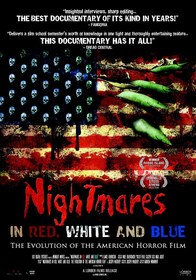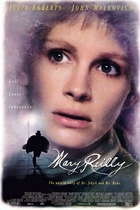Our editor-in-chief Nate Yapp is proud to have contributed to the new book Hidden Horror: A Celebration of 101 Underrated and Overlooked Fright Flicks, edited by Aaron Christensen. Another contributors include Anthony Timpone, B.J. Colangelo, Dave Alexander, Classic-Horror.com's own Robert C. Ring and John W. Bowen. Pick up a copy today from Amazon.com!
Nightmares in Red, White and Blue (2009)
Disclaimer: Joseph Maddrey, who wrote this documentary and the book upon which it is based, is an occasional contributor to Classic-Horror.com. I am reviewing the film from a screener sent to me by Maddrey.
Horror is important. If you asked me to sum up the entire point of Classic-Horror.com, it would boil down to that. Horror is important. Horror matters. When done well (and sometimes when done poorly), horror reflects the unconscious group mind of its particular era and culture better than any other genre. Horror reaches into the dark place in all of us, pulls out truth, and forces us to look it straight in the eyes. Andrew Monument and Joseph Maddrey, the director and writer, respectively, of Nightmares in Red, White and Blue appear to agree with this sentiment. In this insanely informative and fascinating documentary, they draw lines between American history and American horror to show how eerily one tends to reflect the other.
Nightmares is based on Maddrey's book of the same name (which is in and of itself a great read). Like the book, the documentary is split into several chapters documenting different decades in history and horror. For instance, "A New World of Gods and Monsters" explores the monster movies of the 1930s and their relation to the Great Depression. Splitting history up this way could have been problematic, given that societal and generic changes don't happen on cue, but here it works. Maddrey and Monument are not only crafting a narrative by using this technique, they're making a point: history and horror work in cycles, cycles that tend to be heavily defined by a handful of events/films which are both culminations of past events/films and the progenitors of future ones.
Most of Nightmares consists of intelligently-mounted interviews with horror directors (John Carpenter, George A. Romero, Roger Corman and more) and genre experts (Dennis Fischer, John Kenneth Muir, and Tony Timpone), intercut with an impressively wide array of movie clips. The topics that the interviewees discuss boil down to "What was horror's effect on society?" and "What was horror's effect on you?" For directors like Larry Cohen and Tom McLoughlin, the two questions appear to be one and the same. Their journey through and alongside horror has been a personal one. Other directors, particularly Carpenter and Mick Garris, happily espouse their theories on societal fear alongside more subjective musings. These different approaches, along with the occasional shop talk digressions when someone is discussing their own film, keep the conversations fresh throughout.
The filmmakers take some time to have fun as well. Discussing The Thing from Another World, Romero comments that doors are constantly being opened throughout, which leads to a montage of door opening clips from the movie. Later, the documentary takes a break for an entertaining music video that highlights the consequences of sex and drugs in the Friday the 13th series. Even little touches, like characters in the film clips pulling in or knocking out the film titles add to the overall fun of Nightmares.
Monument, who is also the film's editor, manages to devote equal love and attention to all eras, even when the number of films to discuss explodes going into the 1970s. However, Monument really shines when he's building a relationship between history and horror. A moment where he links Nixon's 1969 "silent majority" speech with the shambling of undead of Romero's Night of the Living Dead is inspired, as is another where he juxtaposes 1999's The Sixth Sense with 1962's Carnival of Souls. The best parts of Nightmare, however, are the ones where Monument collapses an era or eras into a single string of clips, such as his chronological collage of screams during the documentary's intro; they remind us that even as society changes how horror expresses itself, it's still the same genre at its core.
Any documentary with a scope as broad as the history of American horror will never be completely satisfactory; Nightmares in Red, White and Blue is no exception. Probably the most irritating moment comes at the very beginning, when narrator Lance Henriksen (using all of the awesome gravitas at his disposal) announces that the American horror film died on arrival with Edison's Frankenstein in 1910 and wouldn't get another go for twenty years (presumably in 1931 with Dracula and Frankenstein). Not only is this a downer, but the statement is actively contradicted during the discussion of Lon Chaney Sr. and silent-era horror (and a good thing, too, because there are some fascinating correlations made between the aftermath of World War I and Chaney's series of amputees and grotesques). Additionally, the Civil Rights Movement of the 1960s is virtually ignored, except for some brief commentary on Duane Jones in Night of the Living Dead; valuable time is instead eaten up by Corman's non-horror LSD movie The Trip.
As accessible as it is smart, Nightmares in Red, White and Blue provides a unique perspective on the rise of the American horror film to meet the demands of a changing society. Horror fans looking to dig deeper into what makes the genre tick should find this documentary indispensable.









This is a great review. It is
This is a great review. It is really interesting how he put all this together and told history through the use of horror films.
I think it will do well and many are going to like it!
Nate, thanks for the highly
Nate, thanks for the highly informative review! I have been curious about this documentary for awhile now, and your piece has definitely peaked my interest.
The best film doc of any kind
The best film doc of any kind I've seen since Visions of Light (92). I do wish The RIng would have been covered in the post-9-11 chapter. It did not use the torture techniques so prevalent in horror the last 10 years, but pure atmosphere and genuine scares. I've watched this doc 3 times in the last month and have encouraged family and friends to watch it to see why I love this genre so much!